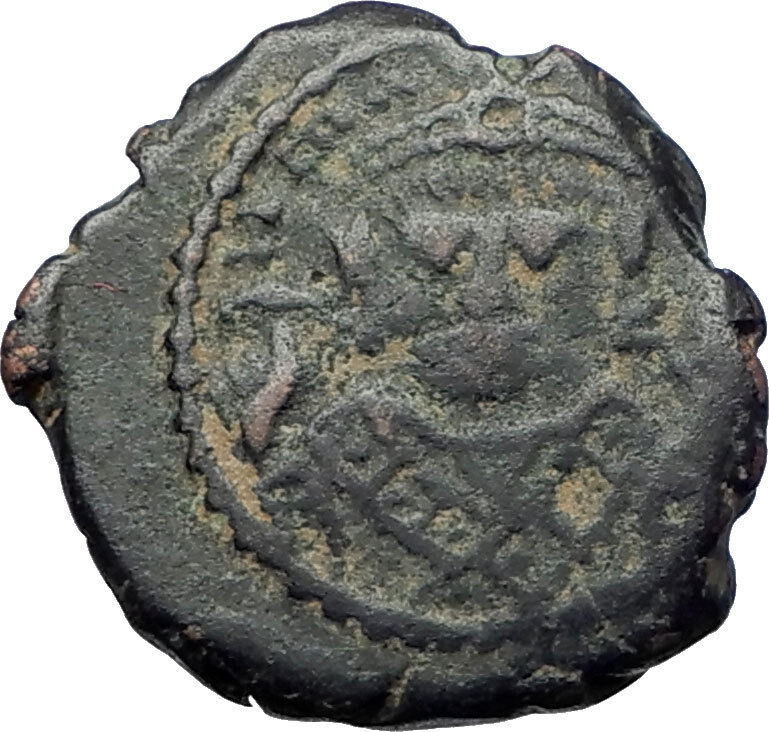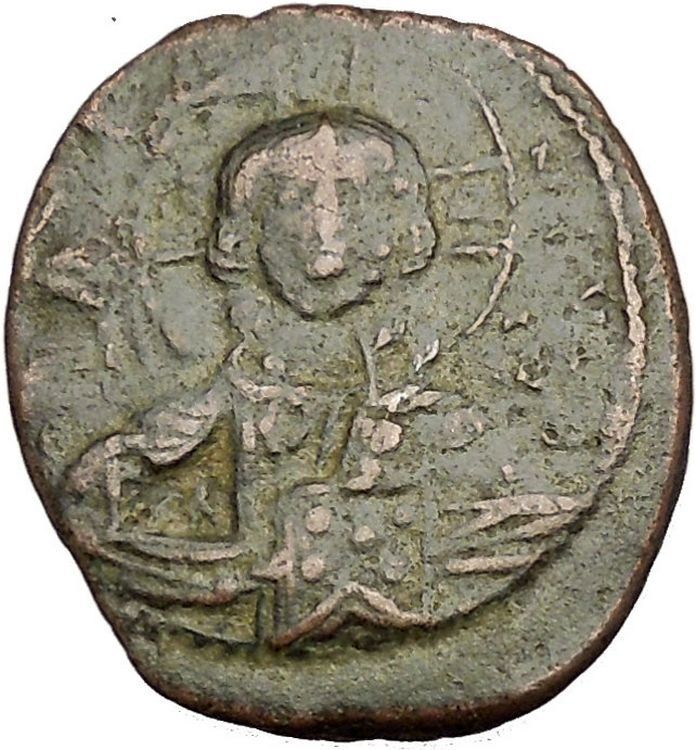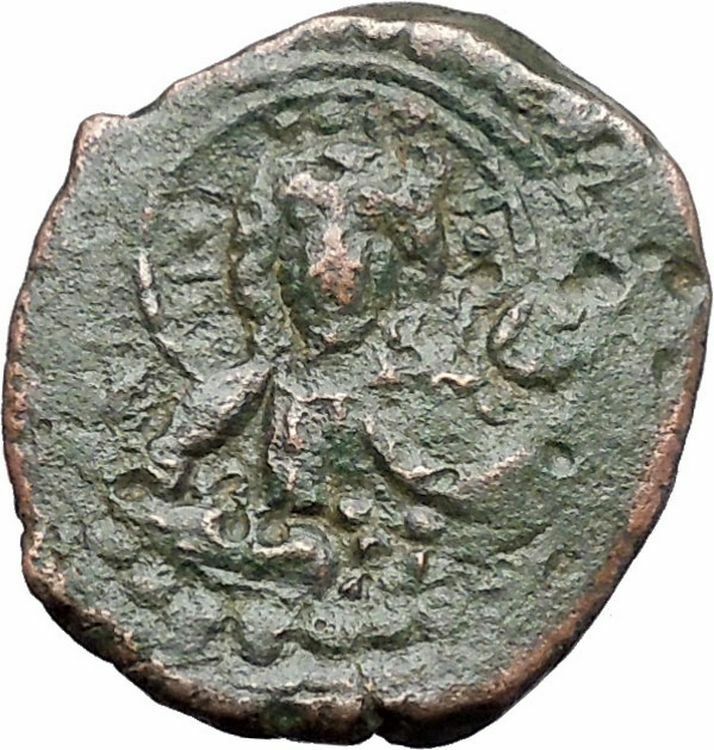|
Byzantine Empir
Basil I, the Macedonian – Emperor: September 23, 867 – August 28, 886 A.D. –
with Associate Rulers:
Leo VI, Augustus from January 6, 870 A.D.
& Constantine, Augustus from February 10, 868 – September 3, 879 A.D.
Bronze Follis 26mm (7.52 grams) Constantinople mint: 870-879 A.D.
Reference: Sear 1712
+ LЄOn bASIL S COnSτ AUGG’ – Facing half-length figures of Basil (in center), Leo (on left) and Constantine (on right), the father with short beard, his two sons beardless; Basil wears crown and loros, and holds akakia in left hand; his sons each wear crown and chlamys.
+ bASIL / COnSτAn / τ S LЄOn Єn / ΘO bASILS / ROmЄOn in five lines, star beneath.
You are bidding on the exact item pictured, provided with a Certificate of Authenticity and Lifetime Guarantee of Authenticity.
Basil I, called the Macedonian (Greek: Βασίλειος ὁ Μακεδών, Basíleios hō Makedṓn; 830/835 – 29 August 886) was a Byzantine emperor of Armenian descent who reigned from 867 to 886. Born a simple peasant in Thrace, he rose in the imperial court, and usurped the imperial throne from Michael III. Despite his humble origins, he showed great ability in running the affairs of state, leading a revival of imperial power and to a renaissance of Byzantine art. He was perceived by the Byzantines as one of their greatest emperors, and the dynasty he founded, the Macedonian (Greek: Μακεδονική δυναστεία), ruled over what is regarded as Byzantium’s most glorious and prosperous era.
From peasant to emperor
Basil was born to Armenian parents in the 830s in the Byzantine theme of Macedonia (an administrative division corresponding to the area of Adrianople in Thrace). While one source has claimed him to be of Slavic descent, such assumptions have been dismissed as fiction by the scholarly world. The sole foundation of the Slavonic theory is that Arabic writers designate him as a Slav; this is explained by the Arabic view that all Macedonians were Slavs. Basil’s first language was Armenian, and he spoke Greek with a heavy accent. A later story asserted that he had spent a part of his childhood in captivity in Bulgaria, where his family had, allegedly, been carried off as captives of the Khan Krum in 813. Basil lived there until 836, when he and several others escaped to Byzantine-held territory in Thrace.
Basil was ultimately lucky enough to enter the service of Theophilitzes, a relative of the Caesar Bardas (the uncle of Emperor Michael III), as groom. While serving Theophilitzes, he visited the city of Patras, where he gained the favor of Danielis, a wealthy woman who took him into her household and endowed him with a fortune. He also earned the notice of Michael III by winning a victory over a Bulgarian champion in a wrestling match, and soon became the emperor’s companion and bodyguard (parakoimomenos).
On Michael’s orders, he divorced his wife Maria and married Eudokia Ingerina, Michael’s favorite mistress in around 865. It was commonly believed that Leo VI, Basil’s successor and reputed son, was really the son of Michael. Although Basil seems to have shared this belief (and hated Leo), the subsequent promotion of Basil to Caesar and then co-emperor provided the child with a legitimate and imperial parent and secured his succession to the throne.
During an expedition against the Arabs, Basil convinced Michael III that his uncle Bardas coveted the throne, and murdered Bardas with Michael’s approval on April 21, 866. Now Basil became the leading personality at court and was invested in the now vacant dignity of kaisar (Caesar), before being crowned co-emperor on May 26. This promotion may have included Basil’s adoption by Michael III, himself a much younger man. As Michael III started to favor another courtier, Basil decided that his position was being undermined and preempted events by organizing the assassination of Michael on the night of September 23/24, 867.
Reign
Basil I inaugurated a new age in the history of the empire, associated with the dynasty which he founded, the so-called “Macedonian dynasty”. This dynasty oversaw a period of territorial expansion, during which the empire was the strongest power in Europe.
Domestic policies
To secure his family on the throne, Basil I raised his eldest son Constantine (in 869) and his second son Leo (in 870) to co-emperors.
Because of the great legislative work which Basil undertook, he is often called the “second Justinian.” Basil’s laws were collected in the Basilika, consisting of sixty books, and smaller legal manuals known as the Eisagoge. Leo VI was responsible for completing these legal works. Basil’s financial administration was prudent. Consciously desiring to emulate Justinian, Basil also initiated an extensive building program in Constantinople, crowned by the construction of the Nea Ekklesia cathedral.
His ecclesiastical policy was marked by good relations with Rome. One of his first acts was to exile the patriarch Photios and restore his rival Ignatios, whose claims were supported by Pope Adrian II. However, Basil had no intention of yielding to Rome beyond a certain point. The decision of Boris I of Bulgaria to align the new Bulgarian Church with Constantinople was a great blow to Rome, which had hoped to secure it for herself. But on the death of Ignatios in 877, Photios became patriarch again, and there was a virtual, though not a formal, breach with Rome. This was a watershed event in conflicts that led to the Great Schism that ultimately produced the Roman Catholic Church and the Eastern Orthodox Church as separate entities. Church and state supported one another and it was during Basil’s reign as emperor that Photios created a genealogy tree that purported that Basil’s ancestors were not mere peasants as everyone believed but descendants of the Arsacid kings of Armenia.[7] Members of the Macedonian dynasty would come to use this tree to claim their descent from King Tiridates III of Armenia.
Foreign affairs
Basil’s reign was marked by the troublesome ongoing war with the Paulicians, centered on Tephrike on the upper Euphrates, who rebelled, allied with the Arabs, and raided as far as Nicaea, sacking Ephesus. Basil’s general Christopher defeated the Paulicians in 872, and the death of their leader Chrysocheir led to the definite subjection of their state. There was the usual frontier warfare with the Arabs in Asia Minor, which led to little concrete gain, but Byzantium’s eastern frontier was strengthened. The island of Cyprus was recovered, but retained for only seven years.
In the West, Basil allied with Louis II, Holy Roman Emperor against the Arabs and sent a fleet of 139 ships to clear the Adriatic Sea from their raids. With Byzantine help, Louis II captured Bari from the Arabs in 871. The city eventually became Byzantine territory in 876. However, the Byzantine position on Sicily deteriorated, and Syracuse fell to the Emirate of Sicily in 878. This was ultimately Basil’s fault as he had diverted a relief fleet from Sicily to haul marble for a church instead. Although most of Sicily was lost, the general Nikephoros Phokas (the Elder) succeeded in taking Taranto and much of Calabria in 880. The successes in the Italian Peninsula opened a new period of Byzantine domination there. Above all, the Byzantines were beginning to establish a strong presence in the Mediterranean Sea, and especially the Adriatic.
Basil’s spirits declined in 879, when his eldest and favorite son Constantine died. Basil now raised his youngest son Alexander to co-emperor. Basil got on badly with Leo, whom he probably suspected of being the son of Michael III. Basil died on August 29, 886 from a fever contracted after a serious hunting accident when his belt was caught in the antlers of a deer, and he was dragged 16 miles through the woods. He was saved by an attendant who cut him loose with a knife, but he suspected the attendant of trying to assassinate him and had the man executed shortly before he himself died.
<phis monetary="" reformation="" included="" in="" the="" introduction="" of=""
|










